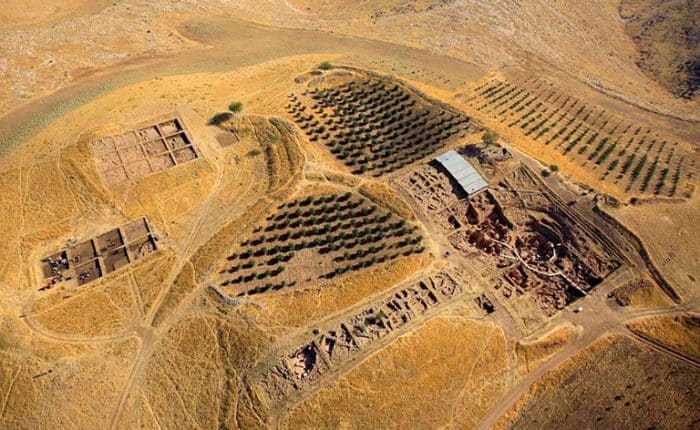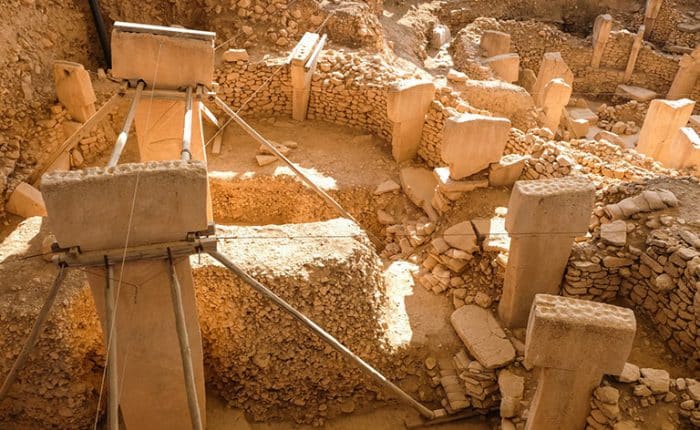Located in Southeast Turkey, the “World’s first temple” was built between 9500 and 8000 BCE, placing it at just about 12,000 years old. The presence of this fascinating excavation naturally changed the learned chronology of Anatolia.
German archaeologist Klaus Schmidt discovered the hilltop in 1963. He thought there had to be something special about the place, and he wasn’t wrong! Excavation began in the 1960s, but it wasn’t until the 1990s that archaeologists unmasked the true scale and age of Gobeklitepe.
It is thought that before its construction, people were living in small, isolated groups with no contact with other groups. But here, you’ll see archeological evidence of many people coming from far and wide to work on the temple.
Gobeklitepe is within Sanliurfa Province, commonly referred to as Urfa. The area’s climate may have been wetter and warmer than today, with a savannah-like landscape. The site would have been about 500km from the nearest sea, at the edge of the Fertile Crescent.
Gobeklitepe is about 50 kilometers from Sanliurfa Airport. Car rental or our tour guide will pick you up from the airport and take you to the city center, where you can explore Gobeklitepe.
Make sure you bring a sturdy pair of shoes, as the site is quite hilly. Also, don’t forget to get a nice camera as the site is open to the public and offers breathtaking views of the surrounding area.
A day to explore the site thoroughly is enough, but we highly recommend sparing more time to be able to cover the other highlights nearby. There’s no doubt that a visit to this site is going to be an unforgettable experience.
The best time to visit Gobeklitepe is from spring to autumn (April to October). The weather is warm and sunny, and the site is open for longer hours.
If you are visiting from November to March, be aware that the site is closed on Mondays and that the opening hours are shorter.
The region is famous for its traditionally-inspired cuisine. Top picks in surrounding restaurants include cig kofte, lahmacun, baklavas, and pistachio-made desserts. But don’t leave before you try the kebabs! Made from marinated lamb and grilled over a coal fire, this dish is a delight to any palate.
And don’t miss out on any opportunity to taste the dessert called “sillik” a crepe-like dessert indigenous to the Southeastern area. It’s made from flour and milk, then filled with ground walnuts and topped with simple syrup and chopped pistachio.
When traveling to Gobeklitepe, wear comfortable shoes and clothes. The site is vast, and you’ll want to be able to explore it without being hindered by your clothing.
Also, don’t forget to bring sunscreen, as the sun can be pretty intense in this part of Turkey. And, make sure to take plenty of water, as it can get pretty hot during the peak summer.
Gobeklitepe is open from spring through the year. Gates open at 8 am and shut at 7 in the evening. However, note that they close two hours earlier (5 pm) for most of the winter.
The best time to visit is between April and early May or late September and October. This way, you escape the sweltering heat of summer and cold, wet winter weather.



The structure of Gobeklitepe is mind-boggling. How did such an ancient civilization build such an intricate and massive temple without modern technology?
The answer may be that Gobeklitepe was built by a highly skilled and organized labor force. In addition, the ancient builders had a great sense of geometry and astronomy, and they used this knowledge to create a perfectly aligned temple.
Historians believe hunter-gatherers built the temple at the end of the ice age – Gobeklitepe at zero point in time. Made for the worship of the dog star, Sirius, it is said to be the world’s first religion.
Gobeklitepe is important because it is unlike any other ancient site. In addition, it offers a fascinating glimpse into the religious beliefs of our ancient ancestors.
The temple consists of the central platform and the surrounding area. The main site is a massive square structure that measures 60 x 60 meters. It is composed of two concentric rings of stone pillars, each made up of 16 posts thought to represent the constellation of Orion.
The central pillars are intricately carved with images of animals, thought to represent the constellations of the zodiac.
These Gobeklitepe carvings, including the vulture stone bunch of grapes stone, and the lion pillar, are some of the most noteworthy examples of ancient art in the world.
The surrounding area is where there are smaller structures called “enclosures.” They are believed to be the homes of the priests who tended this oldest fortified temple complex in the world.
This ancient site is full of history and mystery. Its uniqueness is unparalleled – a must-see for anyone interested in the origins of human civilization. In the race between Gobeklitepe vs. pyramids, Gobeklitepe is the clear winner.
No one knows why Gobeklitepe was built or what happened to the civilization that created it. But one thing is certain – Gobeklitepe is a great site that should be on everyone’s bucket list.
How can you visit Gobeklitepe without touring the rest of this beautiful country? Check out these other incredible places:
But before you head out to these, explore the nearby city, Urfa. This city has a lot to offer, from its rich history to its delicious food. Don’t miss out on seeing Abraham’s Cave, Urfa Castle, and the Balikligol (the Sacred Pool), where you can dive into another story of how religions began.
And finally, no trip to Turkey would be complete without a visit to Istanbul. This city is a must-see, with its stunning architecture, rich culture, and delicious food. Once there, visit the Topkapi Palace, the Hagia Sophia, and the Blue Mosque.